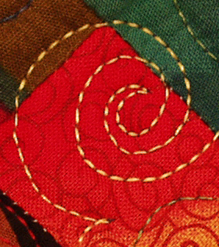Banishing bulky seams
 If you quilt for others, you’ve most certainly encountered a few mountains of fabric at the intersections of patchwork. Poor pressing techniques, inaccurate seam allowances and complex patterns all lead to roadblocks or needle breaks! When the quilt comes to you with these preexisting conditions, you don’t have many alternatives other than to steer clear of the trouble. Select freehand designs that allow you to quilt near the pile up of fabric without risking a needle break or quilt distortion.
If you quilt for others, you’ve most certainly encountered a few mountains of fabric at the intersections of patchwork. Poor pressing techniques, inaccurate seam allowances and complex patterns all lead to roadblocks or needle breaks! When the quilt comes to you with these preexisting conditions, you don’t have many alternatives other than to steer clear of the trouble. Select freehand designs that allow you to quilt near the pile up of fabric without risking a needle break or quilt distortion.
If you must do a pantograph, do a “dry run” across the pattern. Have a helper watch your hopping foot while you follow the pantograph pattern without really quilting. When she sees that your foot is approaching a bulky seam, she can alert you. Then use a dry-erase marker to temporarily re-draft your pantograph pattern on the pattern cover to steer around the seam. Choose a pantograph that has lots of curves and free-flowing movement instead of a very rigid repeating design that will show minor detours from the stitching path.
You do have control over the quilts you create, however. Water can work wonders to help reduce bulk, along with proper pressing. Whenever four or more seams come together at an intersection, press the intersection seams open. Dip one finger into a bowl of water and apply a little extra moisture in the area where the multiple seams meet and fan out. The water will help the cotton fibers to flatten out and compress when you press the seam. Apply firm pressure from the wrong side to help set the seams further. Some quilt shops now sell a novelty item with a rubber mallet end to smash down seams!
Your machine piecing techniques also impact your seam bulk and accuracy. For example, when piecing circular designs like a mariner’s compass, you’ll remove a certain number of degrees every time you do not stitch a completely accurate seam. Instead of a flat quilt you end up with a mountain. To reduce the thickness of machine seams, use a very fine piecing thread and increase your stitch length. With a little forethought you won’t have to deal with bulky seams as an afterthought!



